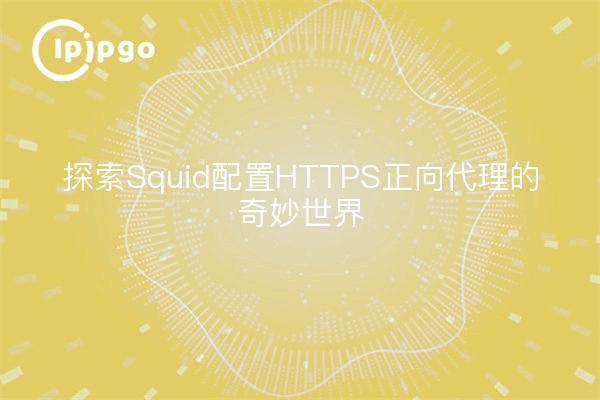
Imagine your network is like a busy highway, and the Squid forward proxy is that smart traffic cop that helps you navigate the road. Today, let's talk about how to configure Squid to implement HTTPS forward proxying and how to better utilize these resources in environments where you need to purchase proxy IP services.
What is Squid Forward Proxy?
First, we have to figure out what Squid forward proxy is. Simply put, Squid is a powerful proxy server software that caches web content and optimizes network traffic. A forward proxy, on the other hand, is when a client accesses a target server through a proxy server. Imagine you go through a proxy to buy something, and that proxy is our Squid forward proxy.
Why choose HTTPS Forward Proxy?
In this age of information explosion, security and privacy are especially important. HTTPS forward proxy not only encrypts your data transmission, but also ensures your privacy from prying eyes. Just like driving on the highway, the HTTPS proxy adds a layer of bulletproof glass to ensure your driving safety.
Basic steps to configure Squid
Now that you understand what a Squid forward proxy is and its advantages, let's get down to business and see how to configure it. Don't worry, it's not complicated, it's like making a delicious home-cooked meal, just follow the steps and you'll be able to do it easily too.
Installing Squid
First, you need to install Squid on your server. for most Linux systems, just run the following command:
sudo apt-get update
sudo apt-get install squid
Once the installation is complete, you can check the version of Squid to make sure it is installed correctly by using the following command:
squid -v
Configuring Squid
After installing Squid, we need to modify the configuration file to implement HTTPS forward proxying. The configuration file is usually located at `/etc/squid/squid.conf`. Open this file and you'll see a ton of configuration options, have no fear, we just need to focus on a few key sections.
Allow HTTPS access
First, we need to allow Squid to handle HTTPS requests. Find the following configuration item and uncomment it:
http_port 3128
https_port 3129 cert=/etc/squid/ssl_cert/myCA.pem key=/etc/squid/ssl_cert/myCA.key
Here `3128` and `3129` are the ports for HTTP and HTTPS respectively, you can change them as needed. `cert` and `key` are your SSL certificate and private key file paths.
Configuring Access Control
Next, we need to configure an access control list (ACL) to ensure that only authorized users can use the proxy. Add the following:
acl localnet src 192.168.1.0/24
http_access allow localnet
Here `192.168.1.0/24` is your local network address segment.
Purchase and configure proxy IP services
In some cases, you may need to purchase a proxy IP service to extend your proxy network. After purchasing the proxy IP service, you will get a set of proxy IP addresses and ports. We need to integrate these proxy IPs into the Squid configuration.
Configure external proxy IP
Assuming you purchased a couple of proxy IP addresses, we need to add those IP addresses to the Squid configuration file. Find and modify the following configuration entries:
cache_peer proxy1.example.com parent 8080 0 no-query default
cache_peer proxy2.example.com parent 8080 0 no-query
cache_peer proxy3.example.com parent 8080 0 no-query
Here `proxy1.example.com`, `proxy2.example.com` and `proxy3.example.com` are the IP addresses of the proxies you purchased and `8080` is the port number. Modify them according to your actual situation.
Configuring Load Balancing
To make better use of these proxy IPs, we can configure load balancing so that Squid automatically selects the optimal proxy IP. add the following configuration item:
cache_peer_access proxy1.example.com allow all
cache_peer_access proxy2.example.com allow all
cache_peer_access proxy3.example.com allow all
This way, Squid will automatically choose the best proxy IP to connect to based on the network conditions.
Generate SSL Certificate
To secure the HTTPS proxy, we need to generate a self-signed SSL certificate. You can use OpenSSL to generate it:
openssl req -new -newkey rsa:2048 -days 365 -nodes -x509 -keyout myCA.key -out myCA.pem
The generated `myCA.key` and `myCA.pem` files need to be placed under the paths specified in the previous configuration file.
Restart the Squid service
Once the configuration is complete, don't forget to restart the Squid service for the configuration to take effect:
sudo systemctl restart squid
Test Your Agents
Once the configuration is complete, you can test your proxy service via a browser or other client software. Set the proxy server address to your Squid server IP and the port to the HTTP or HTTPS port you configured earlier.
If all goes well, you should be able to access the Internet through the Squid proxy. At this point, your network is like an unimpeded highway, and you are the lucky driver in the bulletproof car.
summarize
With this article, we detail how to configure Squid to implement HTTPS forward proxying. Each step is explained in detail, from installation and configuration to generating SSL certificates and how to configure it in an environment where you need to purchase proxy IP services. We hope you can go through these steps and successfully build your own HTTPS forward proxy to make your online world more secure and efficient.
Lastly, remember that online safety is like driving on the road, safety first and caution always prevails. I wish you a smooth journey in the online world and enjoy a safe and convenient online experience!








